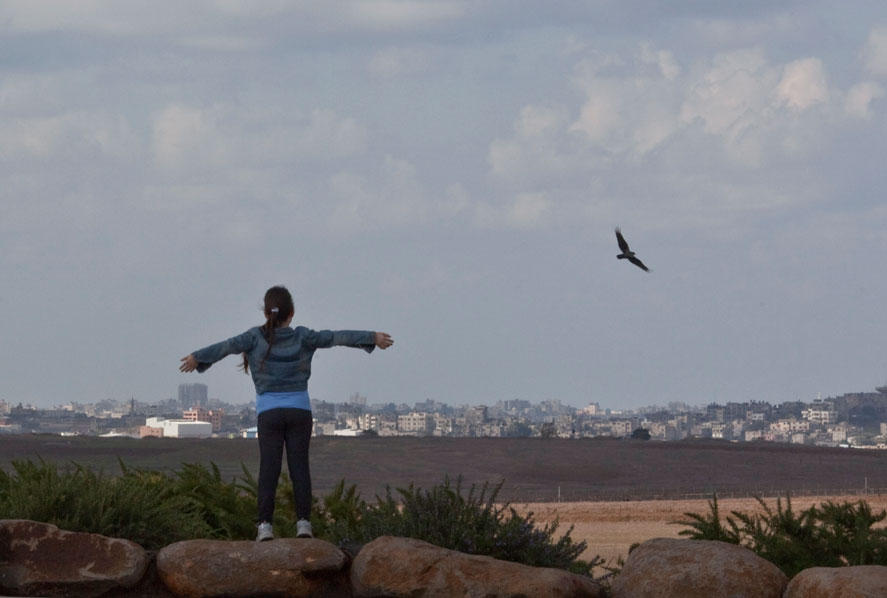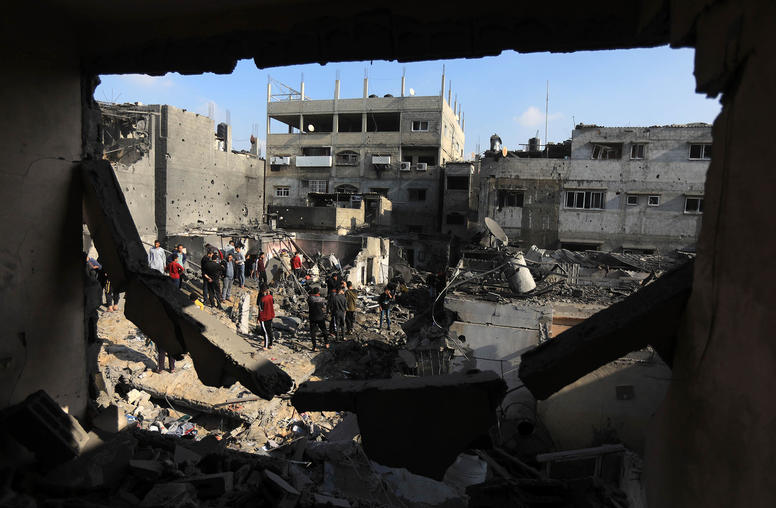Prospects for Middle East Peace
Ahead of President Obama's trip to the Middle East, Lucy Kurtzer-Ellenbogen, USIP’s senior program officer working on issues of the Arab-Israeli conflict discusses broader context.

USIP’s Lucy Kurtzer-Ellenbogen previews President Barack Obama’s trip to the Middle East.
Please briefly describe the Obama administration's approach to Israeli-Palestinian peacemaking in the first term? And did Special Envoy George Mitchell's departure in May 2011, in effect, mark the end of its active efforts to draw the parties closer to allow final negotiations?
In the context of U.S. diplomatic history, President Obama demonstrated rare determination to engage immediately and deeply with the Arab-Israeli conflict from the outset of his presidency. In 2009, on just his second day in office, he appointed former Senator George Mitchell as Special Envoy to the Middle East peace process. This move followed a strongly articulated commitment by candidate Obama –both during the presidential primaries, and election season – to advance the course towards peace between Israelis and Palestinians, and – more broadly – a comprehensive peace between Israel and the Arab world. The overall approach could be characterized as an incremental one.
The administration, via Mitchell, attempted to bring the parties back to the negotiating table via a series of mutually-implemented confidence-building measures. Featuring chiefly among them was U.S. emphasis on Israel’s need to implement a full settlement freeze. This incrementalist plan stalled early on, however, and by the time Mitchell resigned in May 2011, Israelis and Palestinians were engaged in a mutual blame-game as to which side bore responsibility for Mitchell’s inability to bring about progress. U.S.-Israel diplomatic relations were strained – at least on the personal level between Obama and Israeli Prime Minister Benjamin Netanyahu; the Palestinians were pursuing their case by other means, pushing to receive recognition as a state at the United Nations in the face of heavy U.S. and Israeli opposition; and the Fatah-led West Bank leadership was pursuing reconciliation with its militant rival Hamas, which remained unwilling to renounce violence or recognize the state of Israel.
Last, but by no means least, the Arab Spring had sprung. In many ways, both Israeli and Palestinians seemed further apart from even getting back to the table, and U.S. efforts to resolve the conflict now seemed to take a back seat to other regional priorities.
Given the administration’s determination, what accounts for the ongoing stagnation in this process?
There is no shortage of analysis out there on why Obama 1st term administration efforts did not succeed in bringing about substantial progress towards Israeli-Palestinian peace. The recently-published USIP book The Peace Puzzle: America’s Quest for Arab-Israeli Peace, 1989-2011 explores this period in depth. To be sure, as this book articulates, there are lessons to be learned for the president’s second term, if he chooses to engage. But regional developments and dynamics within and between the parties themselves also play a large role in the ongoing stagnation in the process. The lack of mutual trust between the parties persists, and in many ways is deepening. Neither sees the other as a partner for peace, and while Obama administration intentions to bridge this divide via the pursuit of confidence building measures (CBM’s) were not ill-founded, the choice and staging of those CBM’s in many ways further entrenched the parties in their positions and mutual mistrust. In addition, Israeli and Palestinian societies are deeply divided and so it is difficult to achieve the kind of political consensus in either camp that is needed for the respective leaderships to move back to the negotiating table. It is for this reason that our own work on the Arab-Israeli conflict at USIP has strongly focused on these internal Israeli and Palestinian dynamics over the past few years. On the Israeli side, as one example, USIP has been working with the dialogue group Siyach Shalom (Talking Peace), which has engaged several of the most influential religious and spiritual leaders of the settlement movement in a process of sustained dialogue with prominent Israeli Jewish cultural and political leaders from opposing ideological camps, to elicit and explore respective visions for Israeli-Palestinian peace. Likewise, ongoing conversations with our Palestinian partners in the West Bank also make clear that for many who have traditionally been engaged in conflict resolution efforts, the emphasis is shifting towards a focus on Palestinian society and strengthening of capacity to deal with a host of internal dynamics. In some cases, this does represent a deliberate and ideologically-driven choice not to engage in traditional cross-border Israeli-Palestinian activities whether out of a sense of futility and/or opposition to “normalizing” relations with “the other.” In other cases, the choice is borne out of a conviction that internal capacity to bridge divides, manage conflict, and create an empowered citizenship are both necessary for the health of a vibrant and viable future Palestinian state, and ultimately of service to the cause of forging peace with the other side.
What has this frustrating period for peace efforts meant for non-official talks between Israelis and Palestinians--that is, discussions often characterized as Track 1.5, Track 2, and other people-to-people contacts?
It’s a mixed bag. As noted above, there has been a move away from traditional “people-to-people” work at the grassroots level. On the Palestinian side, in particular, this ties in with a growing push towards “anti-normalization” in Palestinian society borne of a frustration at the lack of progress towards achieving a Palestinian state and a concomitant conviction that engaging with Israelis only masks and enables the ongoing asymmetry of power fostered by Israel’s occupation of the West Bank and Gaza. There of course remain organizations that buck this trend and continue to believe in the necessity of cross-border engagement through different means. One such example is the USIP-grant-supported joint Palestinian-Israeli organization Parents’ Circle, and they are not alone. Friends of the Earth Middle East – a joint Palestinian-Israeli-Jordanian-initiative – is an example of a non-dialogue based initiative that has successfully sustained its joint work tackling shared environmental concerns.
There has also been continued strong Israeli-Palestinian security cooperation on the West Bank – attested to by both sides – and no shortage of contact in either formal Track II arenas or informal contexts – between Israeli and Palestinian interlocutors from the journalistic, NGO, and even political realms. That said, all of those who are part of such joint engagement acknowledge that the environment is getting less conducive to sustained and – more importantly -- productive interaction. The longer the formal diplomatic process remains stalled, with no progress in sight, the more difficult it is for these “bottom-up” efforts to sustain momentum.
In your view, does the U.S. need to re-start a major push for peace in order to avert violence and destabilization in the region? Put another way, can the status quo hold?
Let’s take the last part of the question first: an unequivocal “no.” This is not a static dynamic between Israelis and Palestinians and therefore, by definition, the status quo is unsustainable. The economy on the West Bank is in severe decline. The enmity between the two primary Palestinian factions – Hamas and Fatah – persists, with reconciliation and a unified Palestinian polity ever-elusive. Recent Israeli elections have yielded a coalition government that appears to reflect less – rather than more – of a sense of urgency towards prioritizing the peace process as a national security concern. Security cooperation between Palestinians and Israelis, and a commitment on the West Bank towards nonviolent resistance, has yielded relative quiet over the past couple of years, but as previously discussed in a USIP piece on future risks in the Israeli-Palestinian context, the significant financial strains facing the Palestinians extend to the Palestinian security services, and bode ill for the long-term prospects for stability and quiet. Add to this equation the regional and proximate picture – Syria still in violent turmoil; Egypt mired in domestic instability; the perennial military flare-ups at Israel’s border with Gaza (where an Israel-Hamas ceasefire is holding, for now); and Lebanon, where Hezbollah frequently articulates a readiness to act in defense of its Iranian-sponsors interests; and it becomes clear that “stability” is holding on shaky ground.
So even putting aside Israeli and Palestinian interests at this point, I believe that it is squarely and unequivocally in the interest of our own national security for the U.S. to exert utmost effort to further peace in the region and to head off a deterioration of the security environment. It seems clear that Obama’s trip later this week is not designed to announce a concrete plan or push towards bringing the Israelis and Palestinians back to the negotiating table and on the road towards resolution.
However, the hope is that this trip, coming at the beginning of Obama’s second term, at least denotes a renewed conviction to prioritize this issue on the U.S. foreign policy agenda, and can lead the way to serious engagement that takes account of the needs and interests of all parties, while pursuing the agenda with full conviction in its significance to our own U.S. security concerns.



